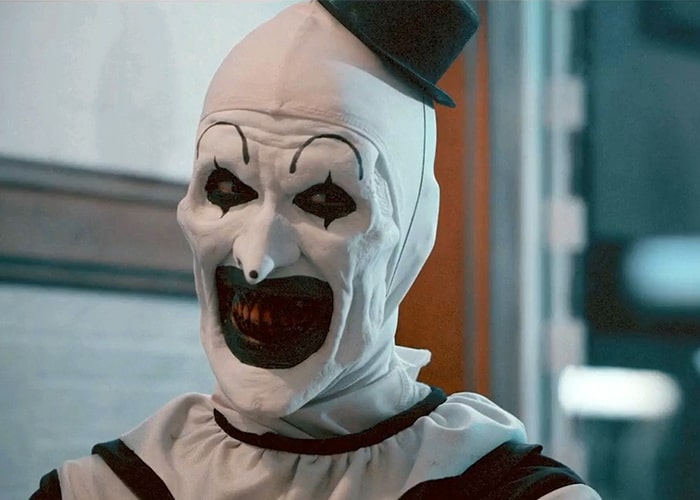This week, we gave our group of interns a challenge: pick a movie from the past decade that didn’t seem like it was for you, so you didn’t see it. Watch that movie and review it. You can find all of their reviews on the Projects page.
Creepy clowns are so hot right now. From big blockbusters such as Joker and IT: Chapter 2 to schlocky B-horror such as Clownado, studios are profiting off of the fear and fascination with people who cover their faces in paint and wear oversized shoes. Something about their too-wide smiles and exaggerated features make these characters appear uncanny and unnatural; they make you want to run away. The fixation with coulrophobia (the name for the fear of clowns) is particularly exemplified in Damien Leone’s insipid and misogynistic Terrifier, in which a clown wields women as a tool of cruel spectacle.
The film opens on an interview between a news anchor and a woman with extensive facial injuries that make her look more monster than human. It’s explained that she is the sole survivor of a Halloween-night massacre executed by Art the Clown (David Howard Thornton). After the interview, the anchor tells her boyfriend how hideous her subject is and how she almost gagged on air. She gets her comeuppance, though, as the woman bursts out from a hiding spot and kills the anchor with little explanation. This is before the clown even enters the picture — right off the bat, there are obvious issues with the film’s tone and pacing.
The film takes us back to the night of the massacre. Best friends Dawn (Catherine Corcoran) and Tara (Jenna Kanell) are drunk after a Halloween party and encounter Art. He is dressed in black and white with black paint ringing his lips in stark contrast to his snow-white face. He creepily grins at them with a mouth that looks like a horrifying void. He does not speak or utter any sounds. He just grins. Then, he makes his move to abduct, torture, and murder these women in an abandoned apartment building. He hacks them up until they are barely recognizable as anything human. Breasts are cut up, faces are shot, and one body is split in half. Women’s bodies are easily disposable to this sadistic clown.
On paper, a single-location horror movie involving a killer clown sounds compelling. There is a Saw-like vibe as Art’s victims navigate the dilapidated and labyrinthine space full of grime and rust. But Leone cannot decide on the right approach. One moment, it feels like a B-movie, from its highly saturated colors to its characters’ stiffly comic line delivery. In the next, it’s a torture porn slasher where the kills are meant to be taken seriously rather than comedically. The filmmakers don’t seem to know what they want Terrifier to be, so they’ve tried to make it all things at once.
Regardless of the film’s tonal issues, though, Art the Clown is a downright bone-chilling villain. Thornton plays the killer creature in his screen debut, and the performance immediately earned him a spot in the hearts of the horror community. His physicality as Art is animalistic as he sniffs the air and bobs his head like a predator hunting its prey. His huge smile is nauseating and never seems to leave his face. His performance is the backbone of the film’s horror. Sure, blood and guts are flying about, but nothing is scarier than the smugly confident grin of that killer clown.
Underneath Thornton’s phenomenal physical performance, however, is still a character with a deep hatred of women. While both men and women are killed in Terrifier, the women receive the most grisly and agonizing deaths. Each man is killed while fully clothed and with quick blunt force head trauma. Women, on the other hand, are stripped down and skinned, sliced, and shot. The naked female body, as in classic slasher films, is a site for spectacle and shock. There’s also a scene in which Art acts like Buffalo Bill from The Silence of the Lambs, a direct homage that perpetuates the stereotype that trans bodies are monstrous.
While horror movies are meant to shock and push boundaries, nothing about this misogynistic treatment of its female characters feels necessary or meaningful in any way. It merely feels like an attempt to see just how brutal a film can be. In some horror films, especially those of the past decade, violence against women is employed to make a point about rampant misogyny within the genre. But Terrifier takes two giant steps back in the direction of horror’s politically incorrect past. There is no payoff or larger message here. It’s just about malice.
Though its central antagonist is, in fact, terrifying, Terrifier is essentially a piece of torture porn with nothing interesting to say. Leone wants it to be a slasher film for the 2010s, with Art the Clown joining the ranks of Michael Myers and Jason Voorhees. While Art does follow in the footsteps of those horror giants, Terrifier doesn’t try to build on the genre in any meaningful way. The film has found its audience with those who are delighted by nonstop gore and vicious killers, but it’s a vapid attempt to create something new and exciting. Sure, it is creative in its kills, but oftentimes that creativity is steeped in mean-spirited cruelty. Ultimately, it’s not so much a slasher film as a piece of sensationalist torture porn about the destruction of the female body.
Terrifier is regressive in its reliance on harmful misogynistic and transphobic tropes that, while utilized in previous decades of horror, feel out of place alongside the horror films of today. Leone created a film solely to shock, offend, and disgust audiences. While he may have achieved that goal, it doesn’t make Terrifier any more necessary or enjoyable.

